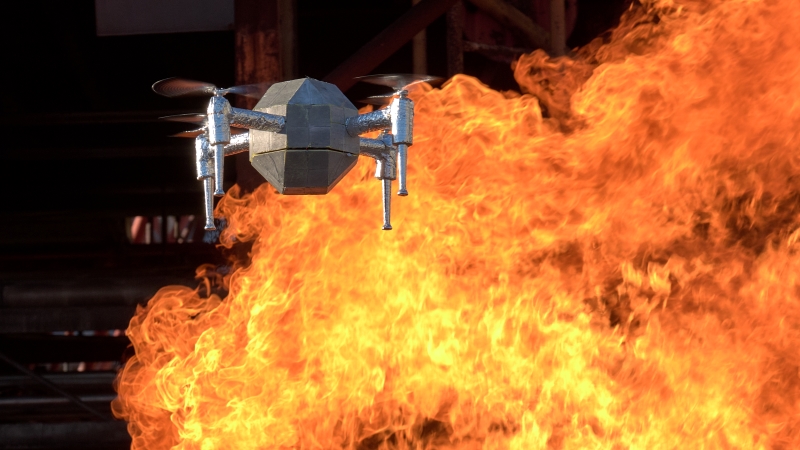Drone takes the heat
A ‘FireDrone’ that can withstand high-enough temperatures to enter burning buildings or woodlands could be deployed to assess hazards and provide data to first responders.

Made of 15mm-thick thermal aerogel insulation, the prototype from researchers at Imperial College London, UK, and Empa, Switzerland, also has an inbuilt cooling system to help it withstand 200°C for 10 minutes.
Drones are currently used to take aerial footage of fires, hoist fire hoses up skyscrapers, or drop fire retardants in remote areas to slow wildfires. However, they cannot fly too close to flames as their frames melt and electronics fail.
After interviewing firefighters, the researchers believe that drones could better prepare first responders. Equipping the devices with cameras and CO₂ sensors, for example, could give crucial information about the fire layout and composition.
To develop the fire-resistant instrument, the team took inspiration from animals that live in extreme temperatures, such as the penguin, artic fox and spittlebug, which have layers of fat or fur, or produce their own thermoregulating material that allows them to thrive.
The FireDrone has a protective structural shell of lightweight, thermally super-insulating materials such as polyimide aerogel with embedded silica aerogel particles and glass fibres. This prevents the materials from shrinking and pore structures degrading. The insulation is then coated with a super-reflecting aluminium to reflect thermal radiation.
The team started from scratch and developed multiple concepts. After preliminary prototype tests of the sub-systems, such as the drivetrain, electronics and thermal insulation, they then formulated the final design.
First author David Häusermann from Empa says, 'Polyimide aerogels have already existed before. What is special, is the simultaneous co-development of the drone system and the aerogel insulation material, this way the material properties could be tailored to our needs.'
The insulation protects the temperature-sensitive components and electronics within the exoskeleton, such as the regular and infrared cameras, CO₂ sensors, video transmitters, flight controllers, batteries and radio receivers. The release and evaporation of gas from the CO₂ sensors is used to build an internal cooling system.
'Electronic components themselves create heat as well. Usually, drones are cooled by the airflow around them. However, in our case, this outside air is hotter than the electronics can handle, therefore the internal cooling system compensates the heat generated by the electronic components,' highlights Häusermann.
The prototype has been tested in temperature-controlled chambers and flown close to flames at a firefighter training centre, however, only within line of sight so far.
The system is conceptually designed for a 10-minute flight time, so that the inner wall does not exceed 40°C – the maximum the battery can handle. The external wall is subjected to 200°C.
The internal cooling system can also only cool the device for 10 minutes. 'After the flight, the drone can cool down, and the batteries and CO₂ cartridge can be exchanged and it can be flown again, without repairs,' shares Häusermann.
The team hopes that further miniaturisation and adding more sensors might lead to its real-life deployment. A smaller drone would require less aerogel material and this would help scale up manufacturing for multiple versions.
The drone can also be used in extreme cold, the team reports. They have tested the drone in a glacier tunnel in Switzerland to study how it behaves in cold temperatures. 'In a cold environment, the heat created by the electronics is beneficial to keep the battery warm within operation temperature. Therefore, the internal cooling system could be removed and, due to the saved weight, the flight time could increase,' points out Häusermann.
The group is now validating the technology with industrial stakeholders and partners.







